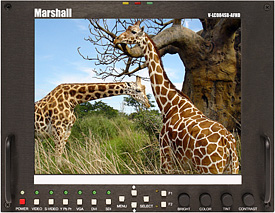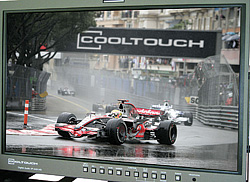LCD Monitors Edge Out Older Technology

This Tamuz LCD video monitor also provides audio level information.PADUCAH, KY.
There was a time when part of my job description included "monitor color matching."
Fortunately, we didn't rely totally on our "visual acuity" for matching those monitors. There was a certain order in the universe then. First, the color monitor had to be able to display a "gray scale" when no color component was present. Next, the contrast and brightness had to be adjusted so that the proper black chips were both visible and invisible, and finally, by using either a little blue filter that I carried around in my shirt pocket or the "blue only" setting on the better pro monitors, I was able to adjust saturation and phase. That was it, no color temperature probes—nothing fancy. As technology progressed (or I should say reached our neck of the woods), much of the guess work, or at least the subjective variables, were removed from the process.

Marshall offers high-definition LCD monitors in a variety of screen sizes. In today's broadcast facility, either in the field or the studio, there are more facets to video monitors than ever before. One of the biggest changes taking place is the move away from CRT displays. Broadcasters are witnessing the CRT's fall from favor and replacement by some type of LCD display. This is especially true in field applications.
TODAY'S TRENDS
There are many manufacturers of LCD monitors now, and many dynamics driving the display industry. Corporate leaders seem to have differing views of the foreseeable future.
"JVC follows the marketplace and the glass manufacturers" said Craig Yanagi, national marketing manager for JVC. "JVC has a focus on improving current technologies, and adding features such as 3G compatibility as demand continues to grow."
Nathan Mordukhay, vice president of marketing for Marshall Electronics says that the company is constantly exploring advances in display science, but is aware of certain tradeoffs too.

CoolTouch's XP-2401 LCD monitor is part of a growing number of large screen HD displays. "We're always looking at new technologies, however many cutting edge display technologies are either not yet ready for market or the price point is prohibitive when first introduced."
Some manufacturers see their roles as more specific, such as Dave Hartman, Importer for Tamuz USA and Tamuz Broadcast Company, a leading monitor manufacturer in Germany, "With our focus on high-end displays, we may see technologies such as organic LED (OLED) displays down the road," Hartman said. "But for now we're focused on providing only the best displays."
Jose Guillen, president of CoolTouch Monitors, says that customer demands for current products are causing their product line to grow rapidly.
"Due to demand, we've had to expand our line to make HD the norm, and we're looking to add dual link 3G in the fourth quarter of '08 and produce models up to 24-inches [which would be] available in quarter four of '08."

Wohler's MON-2WIHR provides users with multiple widescreen high-definition images. According to Guillen, features such as audio de-embedding with confidence monitoring and metering are typical in their product line.
Pushing existing technology forward, some manufacturers are using LED technology for display backlighting instead of traditional fluorescent sources.
"Currently, the trend is to move away from fluorescent backlighting toward LED backlighting for displays, as with our 4.7-inch model," said John Hartwell, CTO for Wohler. "An advantage of LED technology is longer life and the LED's can offer better color temperature on the display."
Once again, opinions can differ in the industry. Tamuz's Hartman says that for the present, Tamuz will be staying with fluorescent backlighting sources. "We're dissatisfied with LED backlight technology."
VIDEO OUTDOORS
Beyond Flat Panels
Although many advances have been made to flat panel displays in recent years, the end is nowhere yet in sight. This is not the forum to debate Plasma vs. LCD displays, or any other competing technology. However, there are some developments that may affect the products we're beginning to accept into our daily lives.
FIELD EMISSION DISPLAYS
To address current limitations on viewing angle, resolution and manufacturing quality, one technology is showing much promise. Field Emission Displays, or FED, is a definite contender to be the display technology of the future.
The nano-Spindt FED reproduces images using an array of nanocone emitters to excite CRT phosphors that have been calibrated to SMPTE/EBU standards. Using those self-emissive phosphors combined with a line-sequential impulse drive system, the FED is said to deliver the performance of a next-generation flat panel.
Advantages include a wider viewing angle, truer color, high contrast with better black reproduction and a sharp display, even with high motion content.
With more than 10,000 emitters used to illuminate each pixel, the images are said to be clear, distortion-free and precisely focused across the entire screen. The high-density emitter array of the FED makes it easy to design a thin panel with low power consumption. There are no backlights or high voltages, and it is possible to maintain high emission for long-term stable operation.
According to some leading monitor manufacturers contacted, availability and price are currently limiting a "mad rush" to FED technology. However, as with most new technologies, it is expected that those issues will disappear as the technology matures.
ROLLABLE DISPLAYS
Looking down the road a little further, another display technology has the potential to change how we look at our cell phones, data devices and portable video displays.
The U.K.-based company Polymer Vision has exhibited a truly flexible monochrome and full-color rollable data display.
These displays are as thin as paper, and have the ability to be rolled up to the diameter of a pen (about 6 mm). The 65 k color display has a resolution of 127 ppi, while the monochrome display has a resolution of 254 ppi, the highest resolution e-paper display ever shown.
Bringing a real product to market with the new technology, the Readius (expected to be launched in the second half of this year), is a definite leap forward. It features a large five-inch rollable e-paper display.
Although motion images are not yet being achieved, it's truly exciting to imagine the possibilities that this technology promises. For a look into the not-so-distant future, visit their Web site (www.polymervision.com/site/page/15/41) and watch the demo.
—Joey Gill
For monitoring applications in an outdoor environment, the manufacturers I approached have different approaches.
"While our HD-mon line offers models that accommodate most any video standard the products also feature field replaceable backlights," said Hartwell. "The HD190 (19-inches), which is 100 percent portable with a 4-pin XLR connector for DC power, is also available with a 'C' mount battery receptacle."
For addressing high ambient light conditions encountered outdoors, Mordukhay says Marshall has developed a special panel with a film that rejects sunlight while keeping proper color and contrast.
However, there are other opinions in this area. "JVC does nothing to impede our crystal clear glass," said Yanagi.
According to Yanagi, the company's non-treated glass provides the highest resolution images possible, especially when coupled with their 10-bit 4:4:4 processing.
"There are plenty of aftermarket sun shading devices to allow viewing in direct sunlight, if needed," Yanagi said.
USER INPUT
For production truck use, LCD monitors have become quite popular. According to Alan Stokes, owner/operator of Stokes Mobile Video Production in Nashville Tenn. says that nearly a third of the company's monitors are LCD. While Stokes isn't using LCD monitors for his primary monitor wall or for QC purposes, he is considering replacing his monitor wall with some type of LCD-based multiviewer system in the near future. And although price does weigh heavily in today's economy, monitoring decisions are not always made about the price point, he said.
"We're placing 200 LG LCD HD sets in the facility at LP Field, Home of the Tennessee Titans," said Stuart Sholar, manager of Studio Engineering and Facilities for NorthStar Studios, in Nashville Tenn.
Sholar says HD content, as well as SD content will be distributed throughout the facility.
"For our production rooms here at our studio, we have seven 65-inch [Panasonic] plasma screens in multiviewer configuration, Sholar said. "We do use an LCD monitor for critical QC in one of our graphic suites, and have a couple more for client confidence/QC use in the field."
However, he says that primary QC duties at the studio still fall to high-end CRT monitors.
Get the TV Tech Newsletter
The professional video industry's #1 source for news, trends and product and tech information. Sign up below.
